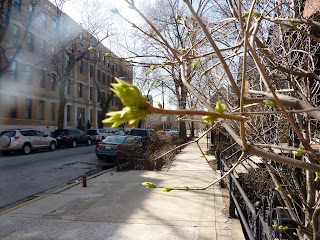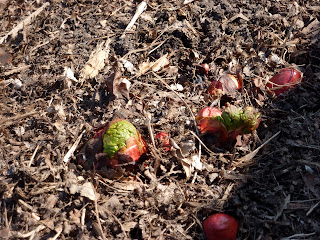A few weeks ago, I explained
how to tell the age of a twig, and last week, I showed you the amazing colors of
photosynthesizing spring twigs. Well, it's apparently twig month. But don't worry, twigs are fascinating, and we haven't wrung all the goodie out of them yet.
 |
| Buckeye leaf buds. |
|
Today we'll focus in on buds, since that is what seems to be the most active biological phenomenon in Chicago at the moment. Buds of many trees and shrubs are starting to grow, and I have become fearful of checking the weather report since we're well before the last frost date for this growth region (April 20). I know we're going to see lots of branches with melty, drippy dead leaves one of these days.
As you can see from the picture above, I finally found a buckeye, the best twigs for learning twig structures. Even with the mediocre picture quality, you can see the giant bud scales and leaf scars. The terminal bud has almost doubled in size and is about ready to pop out some leaves.
 |
| Shrub buds leafing out. |
In the photo above, of a mystery shrub I have not yet identified, the double terminal buds have expanded so much that you can see individual leaves. I didn't stop to get a better picture because the house owner came home while I was photographing his buds, and we had an awkward moment. In a better picture from buds at the Lincoln Park Zoo, below, you can see miniature leaves, and the terminal bud scales are still present at the base of the leaves. No doubt zoo patrons were wondering why I was taking pictures of a shrub and not the demonstrating chimpanzees right behind me. They'll just have to start subscribing to my blog to find out. Loyal readers (hi Mom and Dad), any guesses why these new leaves are reddish?
 |
| Shrub buds leafing out. |
The picture below introduces you to a new plant structure, the flower bud. There are a cluster of tiny dogwood flower buds between my fingers, surrounded by four flower bud scales. Any plant bud is just a beginning of a new plant structure. So you can have leaf buds, flower buds and even root buds. Inside each bud is a small cluster of the plant equivalent of stem cells. Plants' stem cells are called meristematic tissue, and a cluster of these cells are called a meristem. Meristems are the specific cells capable of growing new plant tissue. Most plants have meristems in their tips, like in buds. Plants like grasses have meristems near their bases, which means they can easily grow back after you run the lawnmower over them.
 |
| Dogwood shrub flower buds. |
Below is a gorgeous magnolia flower bud. You can see hairy bud scales and light pink flower petals beginning to emerge.
 |
| Saucer magnolia flower buds. |
Next are the flower buds of a plant so famous for buds that it is named after them: the redbud tree. Redbud buds are a little strange - they can grow out of a mature twig or even out of the tree trunk. This phenomenon of flowers emerging from the mature wood instead of from new green growing tips is called cauliflory, and it's quite unusual.
 |
| Redbud buds. |
I've saved the best picture for last. I found these strange objects on the ground in the perennial garden section of the Chicago Botanical Garden. There are red, papery bud scales and bunched up green leaf babies crammed inside the red buds emerging straight from the ground. I had to ask, since I've never seen these before, and it turns out they are rhubarb buds! The leaves will expand and grow remarkably quickly, since they are so fully formed inside the buds. Then I will turn the stems into a pie.
 |
| Rhubarb buds. |